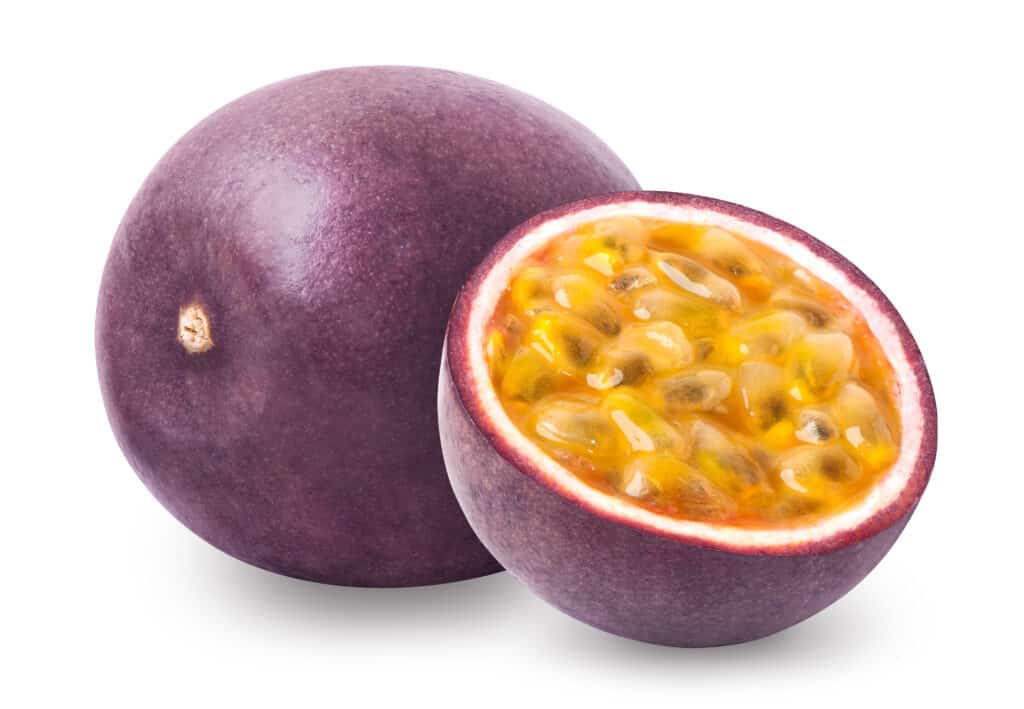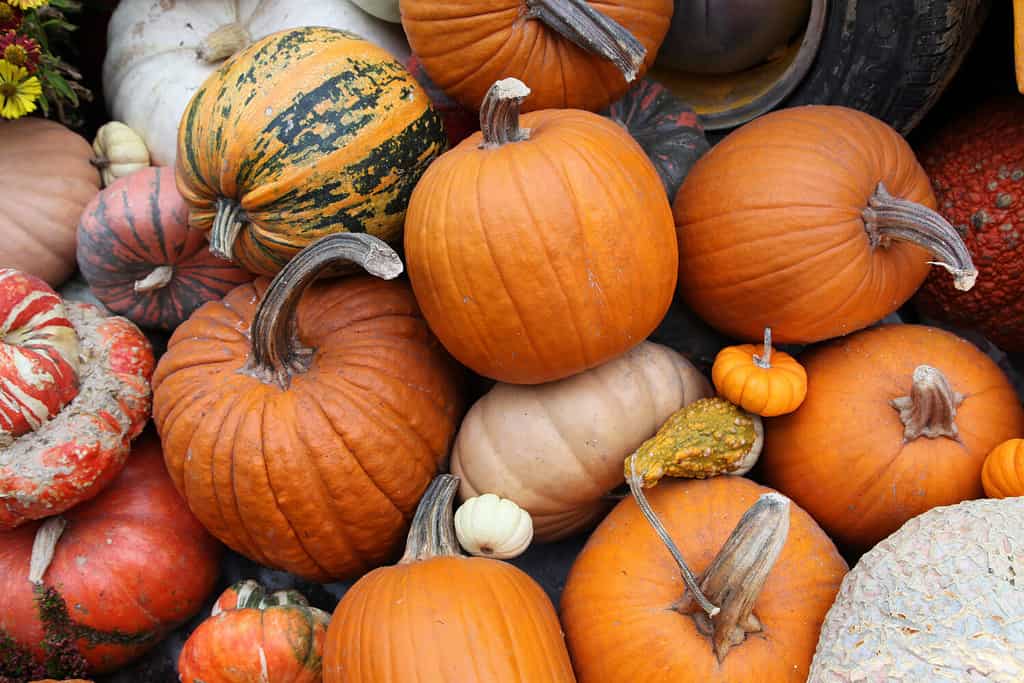Good things come to those who wait, and no one knows that better than gardeners. Growing fruit is a long game. It can take years for some trees, like apple or cherry, to produce edible fruit. Fruits that grow on vines or bushes become mature more quickly than fruit grown on trees. If you don’t want to wait a long time to get some yummy homegrown goodness from your garden, then consider planting these quick-growing fruits!
1. Watermelon (Citrullus lanatus)

Watermelons consist of 92 percent water.
©ABCDstock/Shutterstock.com
Few things are better on a hot summer day than an ice-cold slice of watermelon. Imagine simply walking out to your garden and pulling a watermelon off the vine! Plant watermelon seeds in rich, well-draining soil. Watermelons like moist but not wet soil conditions. This plant does well in hot, humid weather. Some gardeners place pieces of ventilated black plastic over the soil in their watermelon patch to ensure a suitable growing environment.
Three general classifications of watermelon exist. Early-season watermelons are small enough to fit inside a refrigerator. Those take between 70 to 75 days to mature and ripen. Main-season watermelons are greater in size, taking 80 to 90 days to become ripe. Seedless watermelons are generally sweeter than other watermelons. Those take up to 90 days to ripen.
2. Purple Passion Fruit (Passiflora edulis)

Passion fruit vines have a lifespan of seven years.
©Ekaterina Simonova/Shutterstock.com
While it may not be pretty on the inside, purple passion fruit is a delightful natural treat! Passion fruits grow on vines that grow up to 20 feet per year. Those vines will need a support structure, such as a fence or trellis. Plant passion fruit where it will receive full sun. Loamy-rich soil is the best growing medium for these plants, which require good drainage. Amend the soil with compost and mulch if necessary.
After the flowers are pollinated, oval-shaped passion fruits will begin to appear within 70 to 80 days. You’ll know they’re ripe when the skin looks purple and wrinkly. On the inside, passion fruits are similar to pomegranates. Numerous seeds are surrounded by a yellow, jelly-like pulp. Both the seeds and the pulp are edible. Passion fruit contains vitamins A and C, as well as essential nutrients and fiber.
3. Strawberries (Fragaria x ananassa)

Approximately 3 billion pounds of strawberries are grown every year in the U.S., more than any other country.
©V_Sot_Visual_Content/Shutterstock.com
Suitable for planting in the ground or in a container, strawberries are one of the most popular fruits. Strawberries are a sweet delight, perfect for multiple culinary uses. Who hasn’t indulged in a piece of delicious strawberry shortcake? Strawberry plants are easy to grow, and you won’t have to wait too long before they begin producing fruit.
Strawberries can be set in the ground when the soil is warm, often around the end of March. Planting strawberries where they will receive full sun will result in the best fruit production. Strawberries love deep, rich, and loamy soil. If placed in the garden, allow for at least 18 inches between plants. Containers for strawberry planting should be at least eight inches deep. Make sure the soil is well drained. Strawberries are susceptible to root rot. Standing water will injure the plants. In the right conditions, you’ll see strawberries within 60 to 90 days!
4. Tomatoes (Solanum lycopersicum)

Common nicknames for tomatoes include love apples and wolf peaches.
©Paul Maguire/Shutterstock.com
Is the tomato a fruit or a vegetable? Botanists consider tomatoes to be a fruit. Since tomatoes develop from one single bloom with one ovary, producing fruits with no pits, tomatoes are technically a berry. However, most people consider the tomato to be a vegetable because of its culinary usage in savory dishes. In fact, the United States Supreme Court ruled that the tomato be classified as a vegetable in 1893. No matter which side of the debate you fall on, tomatoes are a useful and delicious food you can grow wherever there’s good dirt and sunlight.
You can plant tomatoes in the spring when the soil is consistently warm and workable. Tomatoes love full sun, so plant them where they will receive at least eight hours of sun per day. Make sure the soil in your tomato patch is rich and well-draining. Tomatoes prefer slightly acidic soil, so you may need to fortify the dirt with proper amendments. Watering is an important element for growing good tomatoes. Tomato plants need an inch of water per week. Mulching around the base of the plants helps retain moisture. Depending on which variety of tomatoes you plant, you’ll begin seeing fruit within 60 to 100 days!
5. Pumpkins (Cucurbita pepo)

Roasted pumpkin seeds are a popular and healthy snack.
©Jacqui Martin/Shutterstock.com
When pumpkins begin to appear, you know the fall holidays are approaching! You’ll see the bright orange fruits take center stage as part of harvest displays or carved into jack o’lanterns for Halloween. Cooks bring them into the kitchen to create pumpkin soups or delicious pumpkin pies. There’s something magical about pushing aside the big leaves of a pumpkin vine to see how big your pumpkins have gotten. Pumpkins are easy to grow in your own yard, and they could be mature by the time autumn rolls around!
When pumpkins are ready for harvest depends on which variety you choose and when they are planted. Take into consideration when you want to harvest your pumpkins. Miniature pumpkins become mature in 85-90 days while larger ones take up to 120 days. Sow pumpkin seeds when the soil is warm. Pumpkin vines love full sun and rich, well-draining soil. Give pumpkins an inch of water every week. These plants sprawl, with some vines reaching over 20 feet in length. Make sure they have plenty of space and do not plant pumpkins too close together. Proper fertilization helps your pumpkins thrive. Ask your local county extension agent which fertilizers are best for your pumpkin patch.
6. Papaya (Carica papaya)

June is National Papaya Month.
©New Africa/Shutterstock.com
Perfect for frost-free climates, papaya plants produce gorgeous tropical fruits. Similar to guava and mangoes, papayas have sweet orange flesh and small black seeds. Papayas are excellent blended into smoothies, served over ice cream, or all by themselves. Cold weather is not good for papaya, which performs best in USDA Hardiness Zones 9B through 11. Most papayas cultivated for commercial use in the U.S. come from Hawaii. Papayas are also grown in California, Texas, and Florida.
Grown from seed, papayas prefer full sunlight. Plant papayas in well-draining, rich soil. Amend the dirt with compost, if necessary. Water your papaya regularly and evenly, but ensure the soil doesn’t remain soggy to avoid root rot. It takes four months for papaya plants to sprout flowers. After the blooms fade, edible papaya fruit appears in five to six months. From seed to fruit in a year means a speedy harvest for gardeners!
Summary of the 6 Fastest-Growing Fruits for a Quick and Delicious Harvest
| Fruit | Type of Plant | Time to Fruit |
|---|---|---|
| Watermelon | Vine | 65-100 days |
| Purple Passion Fruit | Vine | 70-80 days after pollination |
| Strawberries | Bush | 60-90 days |
| Tomatoes | Vine | 60-100 days |
| Pumpkins | Vine | 85-120 days |
| Papaya | Tree | 6-12 months |
The photo featured at the top of this post is © Erika Anes/Shutterstock.com
Thank you for reading! Have some feedback for us? Contact the AZ Animals editorial team.







